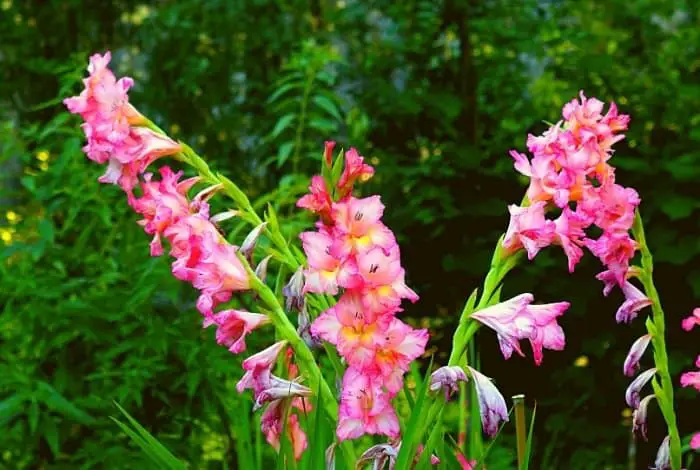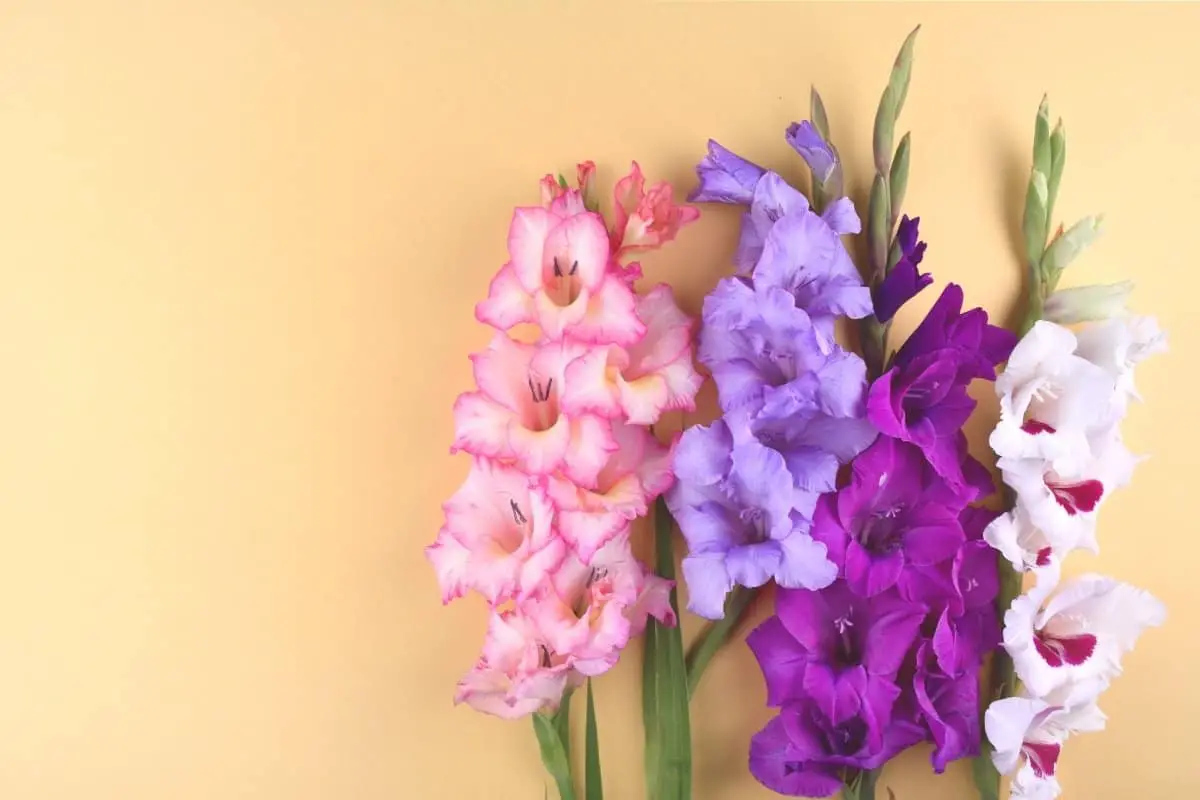Last Updated on January 20, 2022 by
Learning how to plant gladiolus is the first step to growing these classic perennial flowers known for their large colorful blooms.
Commonly referred to as ‘glads’, these lovely flowering plants come in a variety of colors. They grow tall between 2 to 5 feet in height. Their blooms also range in size from small flowers of less than 3 inches in diameter to more than 5 inches across
The ‘glads’ do well in zone 7 and colder. Dig up the gladioli corms in the fall and store them for replanting the following spring. If you choose to grow the taller varieties you will need to give them support.
How To Plant Gladiolus Bulbs – Step By step
Glads need a sunny spot that has well-drained soils with plenty of organic matter to thrive. Let’s look at all the conditions that are favorable for the growth of gladiolus.
Light. These plants thrive best in full sun. They will still flower in part shade, but the colors will not be as livid as when planted in full sun.
Soil. Glads love well-drained soils. A combination of loam and sandy soil works best. If the soil is too wet and heavy, the gladiolus corms will rot. If you only have clay soil, you can still grow these plants. Plant them on raised beds and loosen the soil up to 12 inches deep before planting.
Espoma AP8 8-Quart Organic Potting Mix
Spacing. The corms should be planted 6 to 10 inches apart and 2 to 6 inches deep depending on the size of the corm. The bigger the corm, the deeper you need to plant them.
When to Plant Gladiolus. Plant gladiolus corms at the beginning of spring; 2 weeks before the last frost date.
If you want to enjoy its flowers all summer, plant glads every 2 weeks in spring until early July. This will spread the plantings and flowering times. You can also extend the flowering season by planting different glad varieties – early, mid, and late-season ones.
Care After You Plant Gladiolus
Watering. Water your glads well with at least 1 inch of water each week. You might need to increase these amounts during drought periods if you are rowing them in raised beds.
Fertilizing. Add compost manure to the soil before planting. When the plants are 10 inches tall and when their flowers start to show color, add organic water-soluble fertilizer.
Staking. Tall gladiolus flowers need to be staked or supported so they don’t fall over, become deformed, or curve due to summer winds. After planting, push the flower stakes into the ground next to the plant. Do this early enough so as not to damage the flower. As soon as you notice a flower forming, tie the plant loosely to the stake using a soft material, flower rings, or yarn to support it. After harvesting your flower, you can remove the stakes.
Planting glads in groups next to tall bushy plants is another way to keep them growing upright.
Pruning & Trimming. These flowers do not require trimming or pruning. They are commonly grown as annuals garden flowers or cut flowers for indoor arrangements. Harvest your flower stalks early morning for flower arrangements when the 3 lower blossoms begin to open. Leave at least 4 leaves on the plant to rejuvenate the corms if you plan on saving them for next year. After harvesting, deadhead the flower stalk to prevent the flowers from setting seed and self-sowing all across your beds.
Mulching. To preserve the soil moisture, mulch plants immediately emerge from the soil with at least a 2 to 3-inch mulch layer. Glads hate weeds, but mulching keeps them away. If there are weeds where you want to plant gladiolus, weed before applying the mulch.
Learn more about other flowers:
Enjoy Your Gladiolus
Once you have planted your gladiolus, they should grow well with less attention. The most critical attention should be to keep the soil well-drained but not water-logged.
As they bloom, eradicate the faded and dying flowers to help with continuous growth. Don’t forget to enjoy the cut flowers too!

FAQs
How hard is it to grow Gladiolus?
Gladiolus is a cool-weather bulb that has a natural growth habit. This makes it ideal for those who don’t have much time to devote to planting and maintaining their bulbs. Once planted, they can be left alone until spring, when they’ll begin to grow. Gladiolus are usually planted in fall or spring, depending on the variety.
How do you plant gladiolus?
Gladiolus are best planted in the spring or fall. You can find seeds at most nurseries or buy them online. They prefer a warm and sunny spot. If your soil is too cold, the roots will not grow. You can also plant in pots. Gladiolus are perennials so they will return every year unless they are overwatered.
How do I tell if my gladiolus has been damaged?
There are two ways to tell if your gladiolus has been damaged. First, look at the leaves and see if any have been burned, as this indicates that the plant has been exposed to temperatures above 105 degrees F. Second, look at the flowers.
How do you plant gladioli bulbs in the ground?
Plant them about 12-24" deep and 6-12" apart. The bulbs are shallow-rooted and don't need much soil, so they're easy to transplant once they've been grown for a few weeks.
How long does it take for gladiolus to sprout?
I would guess that it takes a few days to a couple of weeks, depending on the conditions. The best way to tell is to stick it in the ground and see what happens. If you don't get any leaves or flowers in the first couple of months, then you probably have a problem.
Can you grow gladiolus in a container?
Yes, if it is planted in a well drained soil. You will need to water it regularly (at least once per day) to keep the soil moist and prevent root rot. If you are not planning to move your container outside then you may be able to get away with less frequent watering, but even then you should still give it at least one watering each day.
Conclusion
FAQs
How hard is it to grow Gladiolus?
Gladiolus is a cool-weather bulb that has a natural growth habit. This makes it ideal for those who don’t have much time to devote to planting and maintaining their bulbs. Once planted, they can be left alone until spring, when they’ll begin to grow. Gladiolus are usually planted in fall or spring, depending on the variety.
How do you plant gladiolus?
Gladiolus are best planted in the spring or fall. You can find seeds at most nurseries or buy them online. They prefer a warm and sunny spot. If your soil is too cold, the roots will not grow. You can also plant in pots. Gladiolus are perennials so they will return every year unless they are overwatered.
How do I tell if my gladiolus has been damaged?
There are two ways to tell if your gladiolus has been damaged. First, look at the leaves and see if any have been burned, as this indicates that the plant has been exposed to temperatures above 105 degrees F. Second, look at the flowers.
How do you plant gladioli bulbs in the ground?
Plant them about 12-24" deep and 6-12" apart. The bulbs are shallow-rooted and don't need much soil, so they're easy to transplant once they've been grown for a few weeks.
How long does it take for gladiolus to sprout?
I would guess that it takes a few days to a couple of weeks, depending on the conditions. The best way to tell is to stick it in the ground and see what happens. If you don't get any leaves or flowers in the first couple of months, then you probably have a problem.
Can you grow gladiolus in a container?
Yes, if it is planted in a well drained soil. You will need to water it regularly (at least once per day) to keep the soil moist and prevent root rot. If you are not planning to move your container outside then you may be able to get away with less frequent watering, but even then you should still give it at least one watering each day.
Having learned how to plant gladiolus, it is crucial to know that you have a variety to choose from. The types include Gladiolus ‘Miss Green’, Gladiolus ‘Hastings’, Gladiolus nanus ‘Charm’, Gladiolus ‘Happy Weekend’, and Gladiolus colvillei ‘The Bride’.
Each of these varieties is magnificent on its own! Why not try each one of them and see their magical differences while enjoying their bloom?
Oh, and don’t forget, gladiolus is also known as sword lilies because of their blade-like leaves. Don’t wonder what your friends are talking about next time they mention sword lilies.
Caroline is a gardener who loves to get down to the nitty–gritty of gardening. She proudly proclaims herself as a ‘dirt worshipper‘ and can often be found deep in the garden, covered in soil and singing to her plants. As a self–proclaimed ‘plant whisperer‘, Caroline believes that plants need love and attention just like any other living thing, and she loves to give them both. When she‘s not tending to her garden, you can often find her researching the latest gardening trends, or teaching others how to make their gardens thrive



